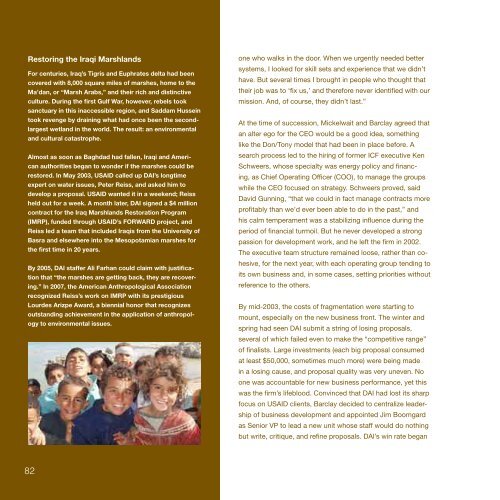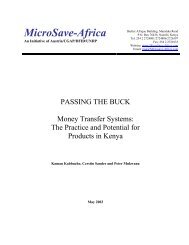You also want an ePaper? Increase the reach of your titles
YUMPU automatically turns print PDFs into web optimized ePapers that Google loves.
Restoring the Iraqi Marshlands<br />
For centuries, Iraq’s Tigris and Euphrates delta had been<br />
covered with 8,000 square miles <strong>of</strong> marshes, home to the<br />
Ma’dan, or “Marsh Arabs,” and their rich and distinctive<br />
culture. During the first Gulf War, however, rebels took<br />
sanctuary in this inaccessible region, and Saddam Hussein<br />
took revenge by draining what had once been the secondlargest<br />
wetland in the world. The result: an environmental<br />
and cultural catastrophe.<br />
Almost as soon as Baghdad had fallen, Iraqi and American<br />
authorities began to wonder if the marshes could be<br />
restored. In May 2003, USAID called up <strong>DAI</strong>’s longtime<br />
expert on water issues, Peter Reiss, and asked him to<br />
develop a proposal. USAID wanted it in a weekend; Reiss<br />
held out for a week. A month later, <strong>DAI</strong> signed a $4 million<br />
contract for the Iraq Marshlands Restoration Program<br />
(IMRP), funded through USAID’s FORWARD project, and<br />
Reiss led a team that included Iraqis from the University <strong>of</strong><br />
Basra and elsewhere into the Mesopotamian marshes for<br />
the first time in 20 <strong>years</strong>.<br />
By 2005, <strong>DAI</strong> staffer Ali Farhan could claim with justification<br />
that “the marshes are getting back, they are recovering.”<br />
In 2007, the American Anthropological Association<br />
recognized Reiss’s work on IMRP with its prestigious<br />
Lourdes Arizpe Award, a biennial honor that recognizes<br />
outstanding achievement in the application <strong>of</strong> anthropology<br />
to environmental issues.<br />
82<br />
one who walks in the door. When we urgently needed better<br />
systems, I looked for skill sets and experience that we didn’t<br />
have. But several times I brought in people who thought that<br />
their job was to ‘fix us,’ and therefore never identified with our<br />
mission. And, <strong>of</strong> course, they didn’t last.”<br />
At the time <strong>of</strong> succession, Mickelwait and Barclay agreed that<br />
an alter ego for the CEO would be a good idea, something<br />
like the Don/Tony model that had been in place before. A<br />
search process led to the hiring <strong>of</strong> former ICF executive Ken<br />
Schweers, whose specialty was energy policy and financing,<br />
as Chief Operating Officer (COO), to manage the groups<br />
while the CEO focused on strategy. Schweers proved, said<br />
David Gunning, “that we could in fact manage contracts more<br />
pr<strong>of</strong>itably than we’d ever been able to do in the past,” and<br />
his calm temperament was a stabilizing influence during the<br />
period <strong>of</strong> financial turmoil. But he never developed a strong<br />
passion for development work, and he left the firm in 2002.<br />
The executive team structure remained loose, rather than cohesive,<br />
for the next year, with each operating group tending to<br />
its own business and, in some cases, setting priorities without<br />
reference to the others.<br />
By mid-2003, the costs <strong>of</strong> fragmentation were starting to<br />
mount, especially on the new business front. The winter and<br />
spring had seen <strong>DAI</strong> submit a string <strong>of</strong> losing proposals,<br />
several <strong>of</strong> which failed even to make the “competitive range”<br />
<strong>of</strong> finalists. Large investments (each big proposal consumed<br />
at least $50,000, sometimes much more) were being made<br />
in a losing cause, and proposal quality was very uneven. No<br />
one was accountable for new business performance, yet this<br />
was the firm’s lifeblood. Convinced that <strong>DAI</strong> had lost its sharp<br />
focus on USAID clients, Barclay decided to centralize leadership<br />
<strong>of</strong> business development and appointed Jim Boomgard<br />
as Senior VP to lead a new unit whose staff would do nothing<br />
but write, critique, and refine proposals. <strong>DAI</strong>’s win rate began



